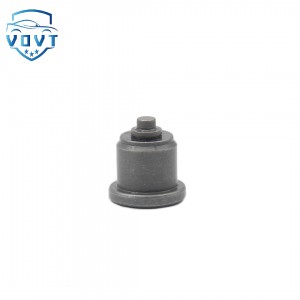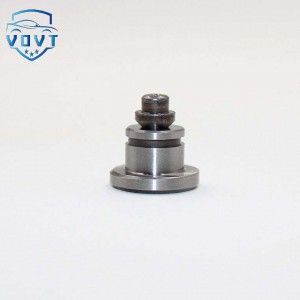High Quality Delivery Valve A36 Diesel Engine Spare Parts
Products Description
| Reference Codes | A36 |
| Application | / |
| MOQ | 12 PCS |
| Certification | ISO9001 |
| Place of Origin | China |
| Packaging | Neutral packing |
| Quality Control | 100% tested before shipment |
| Lead time | 7~15 working days |
| Payment | T/T, L/C, Paypal, Western Union, MoneyGram or as your requirement |
What faults will the abnormal oil outlet valve cause?
Abnormal injection pressure, poor atomization
Fuel injection pressure drops
Wear, deformation or carbon deposition on the sealing cone of the oil outlet valve will lead to poor sealing, leakage of high-pressure fuel during injection, and the actual injection pressure will be lower than the standard value.
Consequences: poor fuel atomization, formation of coarse oil droplets or columnar oil flow, incomplete combustion, engine power reduction, increased fuel consumption, and black smoke (incompletely burned carbon particles) from the exhaust pipe.
Frequent pressure fluctuations
The oil outlet valve is stuck (such as due to impurities or poor lubrication) will cause the opening/closing action to be unsmooth, and the fuel supply pressure fluctuates abnormally with the engine speed, resulting in "high and low".
Consequences: unstable spray shape, uneven combustion, engine idle jitter, acceleration setbacks, and even knocking sounds (local explosion).
Disordered injection time and abnormal combustion
Early or delayed injection
Improper adjustment of the opening pressure of the oil outlet valve (such as weakened or broken spring elasticity) will cause its opening time to be earlier or later than the design value, causing the injection timing to deviate from the optimal angle.
Consequences:
Injection too early: The fuel burns in advance before the piston reaches the compression top dead center, resulting in "pre-ignition", causing engine knocking and difficulty in starting (more obvious when the engine is cold).
Injection too late: The fuel is injected only when the piston moves downward, the combustion efficiency is low, the engine overheats, the exhaust temperature rises, and even white smoke (unburned fuel vapor) is emitted.
Abnormal injection duration
The wear of the pressure relief ring of the oil outlet valve (the pressure relief effect is weakened) will cause the residual pressure in the high-pressure oil pipe to be too high after the injection is completed, delaying the closing of the injector needle valve and prolonging the injection duration ("overspray").
Consequences: The injection amount exceeds the demand, the mixture in the combustion chamber is too rich, the carbon deposits are aggravated, the engine oil is diluted (unburned fuel seeps into the crankcase), and even the three-way catalytic converter is damaged (diesel vehicles may clog the DPF).
Secondary injection or dripping, damage to the engine
Secondary injection
The oil outlet valve pressure relief ring fails (such as excessive wear), and the residual pressure in the high-pressure oil pipe cannot be effectively eliminated. After the main injection is completed, the residual pressure in the pipe may push the fuel out again, forming a "secondary injection" (unexpected additional injection).
Consequences: The secondary injected fuel enters the combustion chamber during the exhaust stroke. At this time, the temperature has dropped and cannot be fully burned, resulting in exhaust pipe blasting and a surge in carbon deposits in the cylinder. The valve or piston top may be burned in the long term.
Fuel dripping
The oil outlet valve and valve seat seal completely fail (such as severe wear or cracks), which will cause the high-pressure fuel to flow back or drip through the oil outlet valve to the low-pressure oil circuit after the injection pump stops supplying oil, and even leak into the combustion chamber through the injector.
Consequences:
It is necessary to pump oil several times to remove air during startup, otherwise it will be difficult to start;
The leaked fuel dilutes the engine oil in the cylinder, reduces the lubrication performance, and aggravates the wear of components such as the piston and crankshaft;
After shutdown, the fuel continues to enter the combustion chamber, and the piston or connecting rod may be damaged by "liquid impact" during the next startup.
Uneven fuel supply and unstable engine operation
In a multi-cylinder engine, if the fuel outlet valve of a cylinder is abnormal (such as inconsistent wear), the fuel supply of each cylinder will be too different (some cylinders have too much/too little fuel supply).
Consequences: The engine will vibrate significantly when running, the idle speed will be unstable, the acceleration will be weak, and even some cylinders will "lack fire", and the exhaust gas concentration discharged from the exhaust pipe will be uneven (sometimes thick and sometime thin).
Intake of air into the fuel system aggravates the fault
When the fuel outlet valve is not sealed well, the low-pressure oil circuit may inhale air in the fuel supply gap (especially when the fuel tank oil level is low), forming air blockage.
Consequences: The fuel supply is interrupted or intermittent, the engine will "wander" (the speed fluctuates), and the flameout will occur, and the air entering will accelerate the wear of precision parts such as the fuel outlet valve and plunger, forming a vicious cycle.























